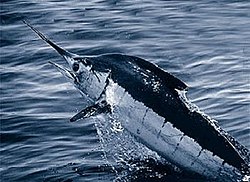Bioaccumulation is the gradual accumulation of substances, such as pesticides or other chemicals, in an organism. Bioaccumulation occurs when an organism...
20 KB (2,276 words) - 20:52, 22 May 2025
because of their contributions to ozone depletion, global warming, bioaccumulation, and toxicity. The area of organofluorine chemistry often requires...
42 KB (4,548 words) - 04:32, 3 June 2025
transport, which allows them to travel far from their source, and bioaccumulation, which reconcentrates these chemical compounds to potentially dangerous...
43 KB (5,655 words) - 12:21, 23 May 2025
interchangeably with "bioaccumulation", an important distinction is drawn between the two, and with bioconcentration. Bioaccumulation occurs within a trophic...
11 KB (1,284 words) - 01:10, 24 May 2025
Creosote (section Bioaccumulation)
effects. Bioaccumulation is the process by which an organism takes in chemicals through ingestion, exposure, and inhalation. Bioaccumulation is broken...
95 KB (10,410 words) - 17:34, 29 May 2025
assess bioaccumulation and bioconcentration. These include: octanol-water partition coefficients (KOW), bioconcentration factors (BCF), bioaccumulation factors...
16 KB (1,887 words) - 17:00, 26 November 2024
Ciguatoxin (section Bioaccumulation)
Ciguatoxins are a class of toxic polycyclic polyethers found in fish that cause ciguatera. There are several different chemicals in this class. "CTX" is...
4 KB (471 words) - 15:17, 18 September 2024
Triclosan (section Bioaccumulation)
which potentially endangers marine organisms and may lead to further bioaccumulation. Ozone is considered to be an effective tool for removing triclosan...
61 KB (6,610 words) - 22:26, 29 May 2025
nontarget organisms. TBT toxicity can lead to biomagnification or bioaccumulation within such nontarget organisms like invertebrates, vertebrates, and...
25 KB (3,039 words) - 19:09, 23 May 2025
Mesopelagic zone (section Bioaccumulation)
approximately 200 fish sampled in the North Atlantic had consumed plastic. Bioaccumulation (a buildup of a certain substance in the adipose tissue) and biomagnification...
50 KB (6,021 words) - 06:18, 23 May 2025
Parabens are organic compounds that are commonly used as preservatives in cosmetic and pharmaceutical products. They are esters of parahydroxybenzoic acid...
19 KB (2,325 words) - 21:48, 29 May 2025
collected from the Murrumbidgee River. The mussel is susceptible to bioaccumulation of hazardous levels of toxins from the cyanobacterium Anabaena circinalis...
2 KB (125 words) - 21:39, 27 May 2025
Atlantic blue marlin (section Bioaccumulation)
known to accumulate in the Atlantic blue marlin, a process known as bioaccumulation. In 2017, the Texas Parks and Wildlife Department issued a consumption...
28 KB (3,233 words) - 09:19, 27 May 2025
nanoplastics (MNPs) are ingestion, inhalation, and dermal contact, with bioaccumulation varying based on particle size, composition, and physicochemical characteristics...
59 KB (6,429 words) - 06:35, 2 June 2025
Biosorption (section Differences from bioaccumulation)
biomass which resulted in a shift in research from bioaccumulation to biosorption. Though bioaccumulation and biosorption are used synonymously, they are...
11 KB (1,424 words) - 17:15, 5 April 2025
the food web Bioaccumulation controls internal concentrations of pollutants, including PFAS, in individual organisms. When bioaccumulation is looked at...
170 KB (17,644 words) - 04:36, 3 June 2025
Because of these factors PBTs have been observed to have a high order of bioaccumulation and biomagnification, very long retention times in various media, and...
22 KB (3,061 words) - 12:46, 11 April 2025
considered water-cleaning ecosystem engineers. They are also important in bioaccumulation and, as a result, as indicator organisms. Filter feeders can be sessile...
28 KB (3,348 words) - 14:36, 25 May 2025
caterpillars, and termites. It is not highly toxic to mammals, but bioaccumulation may be a concern. It has a low level of toxicity to birds and moderate...
3 KB (152 words) - 19:39, 31 March 2025
Agaricus abruptibulbus is a species of mushroom in the genus Agaricus. It is commonly known as the abruptly-bulbous agaricus or the flat-bulb mushroom...
14 KB (1,245 words) - 17:58, 21 May 2025
cadmium sulfide (CdS). It is used for its fluorescent properties. Bioaccumulation of this chemical may occur along the food chain, for example in plants...
3 KB (345 words) - 21:40, 21 December 2023
Phyllanthus balgooyi (section Bioaccumulation)
figure for a Pycnandra acuminata sample from New Caledonia. Due to its bioaccumulation capabilities, P. balgooyi has been brought forward as a potential candidate...
8 KB (898 words) - 21:38, 21 December 2023
groundwater at sites across the United States. The toxicity, mobility and bioaccumulation potential of PFOS and PFOA pose potential adverse effects for the environment...
125 KB (13,081 words) - 04:35, 3 June 2025
can take in plastic pollutants through biomagnification and bioaccumulation. Bioaccumulation is defined as the uptake of chemicals from the environment...
34 KB (4,039 words) - 10:50, 24 May 2025
Triclocarban (section Bioaccumulation)
associated with hydrophobicity, persistence in the environment, and bioaccumulation in fatty tissues of living organisms. For this reason, chlorine is...
30 KB (3,385 words) - 22:26, 29 May 2025
target molecules, forming potent bactericides, but methylmercury's bioaccumulation and ultimate toxicity has led to it being largely abandoned in favor...
17 KB (1,442 words) - 10:46, 31 May 2025
fatty tissue and become increasingly concentrated in predators (see bioaccumulation). Very little is known about the dynamics of particles, especially...
3 KB (388 words) - 14:01, 2 November 2024
are, however, so poorly soluble that this hinders their bioaccumulation. Bioaccumulation is followed by biomagnification. Lipid-soluble compounds are...
87 KB (10,771 words) - 06:33, 2 June 2025
S2CID 219476361. Morel FM, Kraepiel AM, Amyot M (1998). "The chemical cycle and bioaccumulation of mercury". Annual Review of Ecology and Systematics. 29 (1): 543–66...
153 KB (16,245 words) - 17:25, 2 June 2025
chronic toxicity or the consequences of bioaccumulation since siloxanes can be long-lived. Findings about bioaccumulation have been largely based on laboratory...
15 KB (1,529 words) - 10:37, 16 May 2025



















